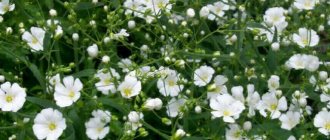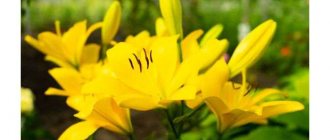Spherical chrysanthemums are in demand in landscape design, they are used to create the borders of flower beds and complement various compositions, as well as to decorate paths. The plant can be called unpretentious, but this applies only to warm seasons, since they have almost no immunity to low temperatures. As soon as the bushes begin to prepare for the dormant period, they require increased attention. Chrysanthemum multiflora: wintering outdoors, how to cover, when to dig up and how to preserve the plant.
Planting chrysanthemum multiflora
You can plant chrysanthemums in the spring with rooted cuttings or by buying a full-fledged plant in a pot with a closed root system. Due to their small size, it is possible to grow multiflora chrysanthemums in containers all the time, but when planted in open ground, they give larger flowers. Chrysanthemum multiflora is a light-loving plant, you should not plant it in the shade, you get stunted bushes with small buds, bent towards the sunlight. When planting, add humus to the planting hole.
How to keep multiflora indoors
In addition to preserving the chrysanthemum without first digging it out on the ground itself, there is a second method, different from the previous one. So, a chrysanthemum dug out with a root and a lump of earth can be stored in a cellar, pot or greenhouse. We will talk about all these storage methods further.
In the cellar
The success of this storage method will largely depend on how well the preliminary preparation of the flower for the frosty period was made, whether the rules for digging out the root system were followed, as well as on the conditions that were created in the basement.

As for the last of the requirements, then before sending the chrysanthemums to their well-deserved rest in the cellar, one should comply with a number of requirements prescribed below:
- a constant low temperature should be maintained in the cellar, whose indicator should vary in the range from 0 to +4 ° С;
- it is necessary to provide the air with the proper concentration of humidity (good, in basements, the humidity is usually high);
- in addition, it is important to ensure ventilation of the air, but at the same time to prevent drafts;
- you need to take care of the sanitary sterility of the room: remove fungus, mold, rodents, insects, etc.
Only by taking into account and fulfilling these conditions, you can load flowers into the cellar.
Chrysanthemum multiflora care
The first feeding can be done 3-4 weeks after planting the rooted cuttings of the plant in a permanent place with carbamide (urea) or other nitrogen fertilizers. In June, fertilizing with potassium monophosphate is carried out to obtain abundant flowering.


Chrysanthemum multiflora
If the chrysanthemum does not bloom or does not have time to bloom before the frost in your area, you should choose earlier varieties of chrysanthemums for growing, since most chrysanthemums are late blooming flowers and bloom only in October. You can slightly extend the growing season and protect the flowers from frost by transplanting the chrysanthemum into a greenhouse.
Varieties and varieties of border flower
All chrysanthemums can be conditionally divided into two groups:
- large-flowered (Indian);
- small-flowered (Korean).
Consider a few locally adapted cultivars.
Branfountain lemon
Delicate lemon, profusely blooming Branfountain Lemon cultivar forms a bush 50 cm high, flowering begins in early September.
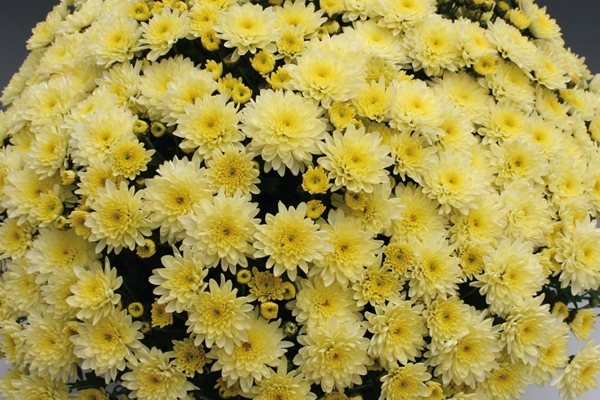

Branfountain Lemon variety
Bransky plum
Bransky Plum cultivar muted red color - rather high, a bush up to 70 cm. The variety can be interestingly beaten when creating multi-tiered garden compositions.
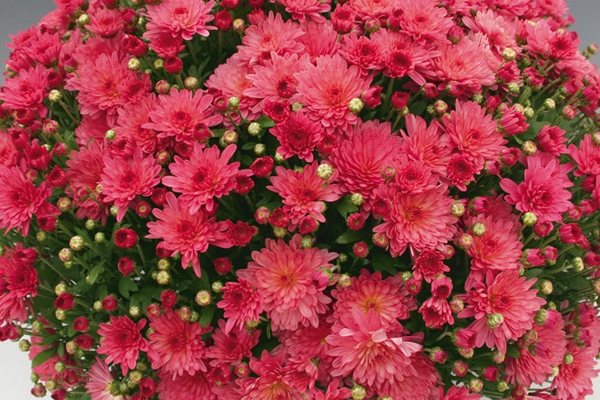

Bransky Plum cultivar
Branroyal yellow
Another high grade among spherical species - Branroyal yellow, which, during flowering, has absolutely no leaves behind the radiant yellow flowers and buds.


Branroyal Yellow variety
Branbeach orange
Branbeach Orange variety begins to bloom quite early, in mid-August; the height of the ball is 50 cm. The variety is attractive with a gentle orange color of the flower.


Branbeach Orange variety
Brandove white
Bicolor pom-shaped flower, light green with white, typical for Brandove White varieties, very good for creating compositions with brightly colored varieties.


Brandove White variety
Branchili
Undersized Branchili cultivar the color of hot pepper, forms a ball 40 cm high, the diameter of the flower is 4 cm.
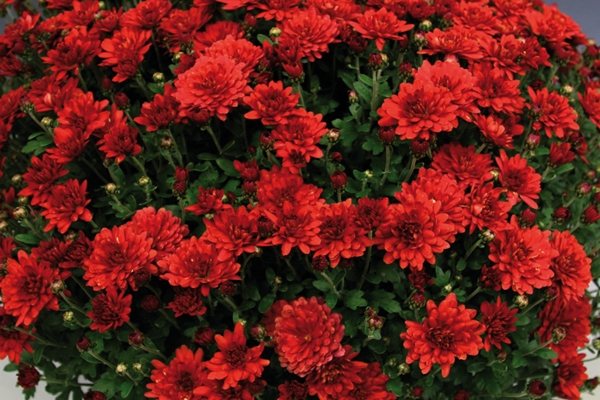

Branchili variety
These are covering varieties that overwinter quite successfully.... In northern regions, it is safer to dig up the plant by storing it in a cool, dark place.
When planting, be sure to take into account the size of an adult bush, observe a distance between seedlings of at least 50 cm.
Chrysanthemum wintering
Chrysanthemums can withstand light frosts, but when predicting stable temperatures of -4 ... -5, chrysanthemums should be removed for winter storage. Chrysanthemums cannot hibernate in the open field in the middle lane. They are destroyed not by frost and snow, but by thaws and subsequent frosts, especially in early spring. There is information from gardeners that in the Middle Volga region, where, due to a more continental climate, there are fewer thaws in the winter season, some varieties hibernate in the open field, for reliability they can still be mulched with fallen leaves and covered with a double layer of spunbond on top.
Chrysanthemums can hibernate in a greenhouse buried in the ground and mulched from above, for example, with humus. To do this, we transplant a flowering bush with a lump into a suitable container, for example, into a bucket and bury this bucket in the greenhouse in the ground, and on top we warm it with a layer of fallen leaves. In the greenhouse above the chrysanthemums, you can arrange a spunbond shelter, which will additionally protect the plants from frost.
After the plant fades or freezes, the aboveground part should be removed with pruning shears.
You can also store the dug chrysanthemums in the cellar, but chrysanthemums do not like wet and cold ground, so you should carefully monitor the soil moisture. If the soil dries up, "dry watering" should be carried out by placing snow on top, which will gradually melt and be absorbed into the ground. It should be borne in mind that at temperatures from +4 and above, chrysanthemums can grow in winter.
How to prepare chrysanthemum for winter
Any plant, gaining strength, is actively nourished with useful substances before going into a state of dormancy, chrysanthemum is no exception. To help the flower withstand subzero temperatures, fertilizers begin to be applied already from the first days of September. In the summer-autumn period, potassium-phosphorus mixtures are ideal, they contribute not only to abundant flowering, but also to strengthen the immune system.
The second, no less important event is pruning. The procedure is carried out as late as possible (when the first frosts take over the ground), so that the juice from all the stems goes to the root, thus avoiding the depletion of the plant. All dry, weakened or spoiled twigs, as well as old shoots, should be removed, there is a risk that in the future they will begin to rot. The rot will spread to the rest of the stems. The main shoots are shortened to 15 cm (miniature varieties up to 10 cm), young shoots can be left as they are.


From the first days of summer until the onset of autumn cold weather, you need to closely monitor the bushes. When the slightest signs of diseases or pests appear, they are immediately sprayed with suitable preparations, it is important not only to cure the chrysanthemum at a certain stage, but also to prevent the reappearance of ailments (to carry out several more preventive treatments).
Cutting chrysanthemum multiflora
Young shoots are suitable for cutting chrysanthemum multiflora, lignified shoots do not take root well. Cuttings should be carried out in the spring.To do this, in February-March, the chrysanthemum should be transferred from the wintering place to a warm room in order to cause the growth of young shoots, which are used for cuttings. It is imperative to provide additional lighting so that the shoots are complete.
Cuttings are harvested with a length of 10-15 centimeters, 2-3 leaves are left on top, and all the rest are removed. You should be careful with the use of root stimulants such as "Kornevin", as delicate cuttings of chrysanthemum often burn out as a result of stimulant treatment. You can soak the cuttings in "Gumi Kuznetsov", and then place the cuttings in containers with earth, ordinary plastic cups will do.
A greenhouse should be created above the cuttings and kept constant so that the leaves do not dry out. It is possible to cuttings in summer, but the survival rate of cuttings in summer is much lower.
What to do with the chrysanthemums bought in the fall and how to preserve them in the winter, see the video below.
When and how to dig
It is necessary to start preparing plants for the winter storage period with the approach of stable frosts (mid-September - early October). When the flowering ends, the peduncles are cut off with sharp garden shears, leaving no more than 10 cm. For preventive purposes, the cut sites are treated with iodine or fungicide, which are good antiseptics and prevent the development of harmful bacteria.
- You need to dig out the roots very carefully, trying not to damage anything. The remains of the soil should not be knocked off them: you need to store chrysanthemums in winter in clods of earth.
- The next stage of preparation is drying. The roots should be kept in a dry, ventilated place for several days.
- If insect larvae are found, the bushes should be treated with insecticides.
It will be possible to save chrysanthemums in winter only if the plants are strong and healthy. Therefore, they should be fed throughout the spring, when these flowers are actively growing.


In the process of grafting
The sequence of actions is as follows:
- Basal shoots 7-8 cm high are separated from the mother bush.
- The main young shoot is cut into cuttings, the lateral ones are not used. The length of each is 5-8 cm. The upper leaves are removed, the lower ones are shortened by half.
- Rooting will be facilitated by immersing the cuttings in a solution of any proven growth stimulant - heterooxin, bioglobin, root, etc.
- Planting material is planted in containers with a substrate, dusting the cut with charcoal. The height of the substrate layer is from 5-6 cm. The cuttings of chrysanthemums should be deepened to a depth of 2.5-3 cm.
- Planting scheme 3 × 4 cm - the plants should not touch the crowns as they develop.
- On top of the substrate, a layer of river sand or perlite is poured in half with coarse sand. Its height is up to 2-3 cm;
- So that the soil mixture "adheres" properly, it is well spilled.
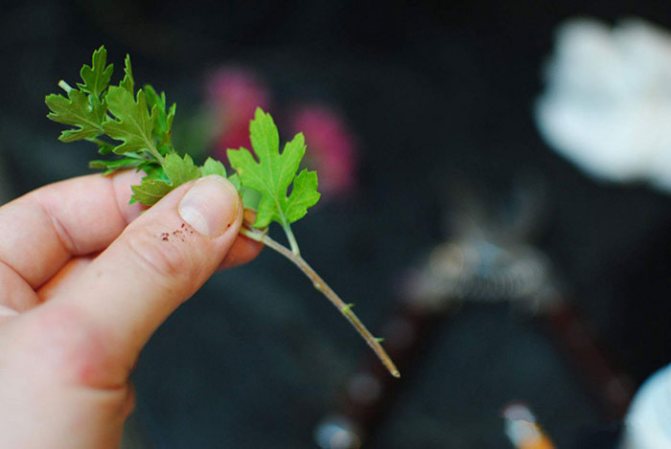

Chrysanthemums are easily propagated by cuttings
There are many options for preparing a soil mixture for cuttings, from those used by flower growers:
- fertile soil (black soil), sand, humus 2: 1: 1/2;
- peat, sod land, coarse sand 1: 1: 1;
- leafy land, soddy, coarse sand 1: 2: 1;
- sandy soil, peat, compost (biohumus) 2: 1: 1.
Attention! The densely planted seedlings are stretched, the roots begin to intertwine - you should keep a distance. Leaves of rooted neighboring plants should barely touch.
Cutting chrysanthemums in the fall, depending on the variety, will yield within 20 bushes.
Winter content
Shelter... Autumn will bring the inhabitants of central Russia and those who live to the north the eternal question - should multiflora be left to winter in the ground? In settlements south of the Moscow region, this chrysanthemum can overwinter under a good air-dry shelter. But what is especially important - if it is planned to shelter the mother liquor, then it should be planted in a place where water does not stagnate.Chrysanthemum easily dies from getting wet. But keep in mind that a bush over 3 years old will no longer give an ideal shape, it will fall apart, or even begin to rot.
Characteristics and description of Multiflora
Chrysanthemum breeding has a very long history, the flower was first mentioned by Confucius in the treatise "Spring and Autumn".
In the east, the flower was eaten, used for medicinal purposes, in perfumery, and only then began to use the decorative properties of the plant.
The Japanese showed a special attitude to the sunny flowerwho considered him royal. Only members of the imperial family could wear clothes with the image of chrysanthemums. The nature of Asia boasts 30 naturally occurring shrub species.
Multiflora was not bred for cutting, like many other large-flowered Indian chrysanthemums. This species is intended for decorating flower beds, has a sharply decorative ball shape, blooms from the end of August until the first snow.
Prefers a sunny, open place for planting, but no drafts. The roots of this plant should not be allowed to flood; avoid planting on swampy soils.
Chrysanthemum forms a healthy bush shape only in a sunny location. She is uncomfortable near trees, even in light partial shade. An oppressed plant will not be able to form a spectacular ball.
Features of the spherical chrysanthemum:

